The theme of this year’s Electronic Entertainment Expo (E3) is, “It all starts here.” Roughly 50,000 industry professionals will converge on the Los Angeles Convention Center during the week of June 10. Tens of millions will watch the event on livestreams. Last year, 50,300 professionals attended and another 20,000 fans visited nearby events. This year, 15,000 fans will get inside the expo for the first time.
And it all starts with one guy. Making sure that it all goes smoothly is the job of Mike Gallagher, CEO of the Entertainment Software Association, the game industry’s trade group and the creator of E3. Gallagher has run the event for a decade, and I talked with him for another pre-E3 interview. (Here’s last year’s interview).
We talked about E3 and issues such as diversity, game jobs in the U.S., Electronic Arts’ withdrawal from the show floor, President Donald Trump’s travel ban, and gaming’s place among the tech titans.
Fun facts: E3 has 81 new companies this year. 126 of the exhibitors are virtual reality companies, compared to 53 last year. There will be more than 100 mobile and social companies. And there are an estimated 2.6 billion gamers on the planet. 2,300 products will be on display, including 75 never-before-seen games.
“That’s 5 billion more to go,” Gallagher said.
Here’s an edited transcript of our talk.
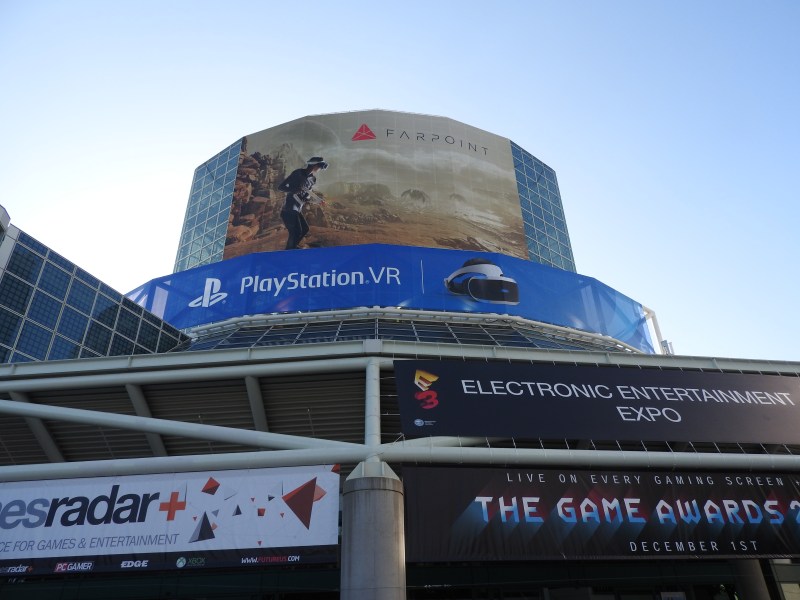
Above: Sony’s banner atop the LA Convention Center
GamesBeat: Are you handling the stress with grace?
Mike Gallagher: It’s interesting, because this year is a little different from prior years. I don’t know if any year is exactly the same as the last one, but this year, with the consumer element and the things we’re building on to the show, it adds excitement, and there’s a sense of urgency, to make sure that we deliver. But otherwise, the fun stuff — there’s just as much to be excited about this year, if not more, if you look at announcements, reveals, VR and AR, all that. It’s going to be a great show.
GamesBeat: What are you expecting as far as the usual numbers go?
Gallagher: The theme is “It all starts here.” For gamers, that’s a clear and obvious statement. They know that E3 is the beginning of the what comes next. It starts at E3, builds throughout the year and is delivered across multiple platforms. The medium continues to grow and expand and excite.
The numbers bear that out. From Twitch’s perspective, looking at engagement, last year’s show had 42 million gamers watching E3 content on Twitch. That’s the highest viewership of any game convention broadcast on Twitch. It’s double the average viewership of the 2016 NBA finals. Culturally, it’s just a juggernaut.
We’re going to have 81 new companies on the E3 floor this year. Those include Lenovo, Cartoon Network, Skydance Interactive, and Engadget. New companies always bring new blood and new approaches to the industry. It brings more vibrancy and health. Another threshold we’re crossing this year, more than 100 E3 exhibitors are in the mobile and social game space. It continues to show E3’s ability to integrate all forms of games across all devices.

Above: For Honor models at E3 trade show.
In the VR/AR/MR space, we have 126 exhibitors. Last year that number was only 53, and the year before it was in the 20s. Next year we probably won’t even count that. Everybody will be doing it. It’s like flat screen TVs. When you think about the emergence of VR/AR/MR, no show in the world brings together more of those companies and demonstrates more of those capabilities than E3.
This industry has been redefining the interface between man and machine from the beginning. The notion that you could make your TV interact with you was the first level. That was done with very primitive programming techniques. But that built forward to arcades and console gaming. The Wii and Kinect brought motion-based gameplay, with and without controls. Now we have competing enhanced reality technologies springing out of E3. I don’t know if you saw the slide deck from Mary Meeker today. She has 70 slides on the breadth, reach, and potential of the game industry, and all of the technology it’s spawned, all the job-creating behaviors it sharpens. It’s worth a look. She pulls together a number of themes and supports those themes.
One third of our E3 exhibitors are international companies. It’s the one true worldwide game show. More than 2,300 products will be exhibited at E3. We know, from what others have told us, that at least 75 of them have never been seen before. That number will of course continue to grow as we approach the show, but that’s what makes E3 go, these reveals and first encounters with new technologies.
This year we have 15,000 gamers coming to the show, as you know. We couldn’t be more delighted to welcome them and include them firsthand in the experience. We’ve designed some new elements purely focused on making sure those consumers have a great experience at E3. The principle thing we’ll have is the E3 Coliseum, where we’ll have some leading folks for them to visit with, but we also have two esports pavilions available so they can watch others or participate themselves in playing the games they love, including new IP in that context. It’s a tribute to the growth curve that the industry continues to define.

Above: Insomniac Games chief Ted Price (left) talks with Mike Gallagher, CEO of the Entertainment Software Association, at the GamesBeat Summit. 2017.
GamesBeat: With all that, do you think attendance will be up on the professional side?
Gallagher: We’re expecting a slight increase, similar to prior years, in professional attendance. On top of that we have the 15,000 consumers. We’ve had a year to prepare for their arrival. You’ll see several of the booths make adaptations to handle more consumers and turn them around quicker than in years past, because of the difference in approach at the show. You’ll also notice things we’ve done as show organizers to provide outlets for consumer enthusiasm outside of the booths, so there’s a greater flow.
We’re going to take a dynamic approach to this show. We’ll learn from what we do, do more of what we’ve done well, and fix the things that don’t go so well. We’re learning as we go. It’s a new beginning for us.
GamesBeat: Activision is back, but Electronic Arts is not. How do you approach that problem?
Gallagher: We see EA having a strong presence in Los Angeles through EA Play and their scheduled press briefings. That’s a clear reflection of the gravity of E3. It’s the one worldwide game conference, where the major players tell the world what’s coming next. EA, in its own way, is amplifying that through its presence and EA Play this year.
EA is a fantastic member of the ESA. They participate in a wide variety of our programs and planning for those programs. When you look at the opportunity that E3 represents, it’s unique. It brings in all the world’s gamers. In prior years we’ve had 55-60 billion media impressions, vastly exceeding any other trade show in this country. Nothing comes close, including CES and Comic-Con. Our goal as show organizers is to deliver great value to our exhibitors that participate in the show directly. We’ve done that this year.
Those 15,000 consumers will be here having direct conversations with exhibitors. They represent the most enthusiastic gamers. They’re exactly the type of gamers you want to have a conversation with and excite about the future. The more we can make the show floor and E3 the place to be for an exhibitor, the more exhibitors are going to come to the show. We look at the opportunity EA represents for us in the years ahead.
GamesBeat: As far as the opportunity or the pitch, you usually talk about — you have to be there because you need to be part of all those impressions that get created, right?
Gallagher: The show officially starts on Tuesday. We now have press briefings from exhibiting members as early as Sunday. To go earlier than that gets further away from the center of gravity that is the show. We believe that the greatest level of engagement is at the show itself, participating in the events that are part of it. That includes access to these consumers and the ability to converse directly with them.
It’s not just the mainstream media anymore, or just retailers. The show has evolved to where it’s ready to engage consumers directly. We’ll see that in full force this year. That breadth of connection is the type of thing we think will bring in new exhibitors. The consumer element is key to a number of the 81 new exhibitors this year. Also, one thing you’ll be able to track as we get closer to the show — you’ll see how many exhibitors came from the suites upstairs to having a booth on the floor. They’re doing that to directly engage with consumers and social media leaders, along with mainstream media, to get closer to that engagement. The better job we do at delivering that — and the value of it is clear — the greater the number of exhibitors E3 will enjoy.
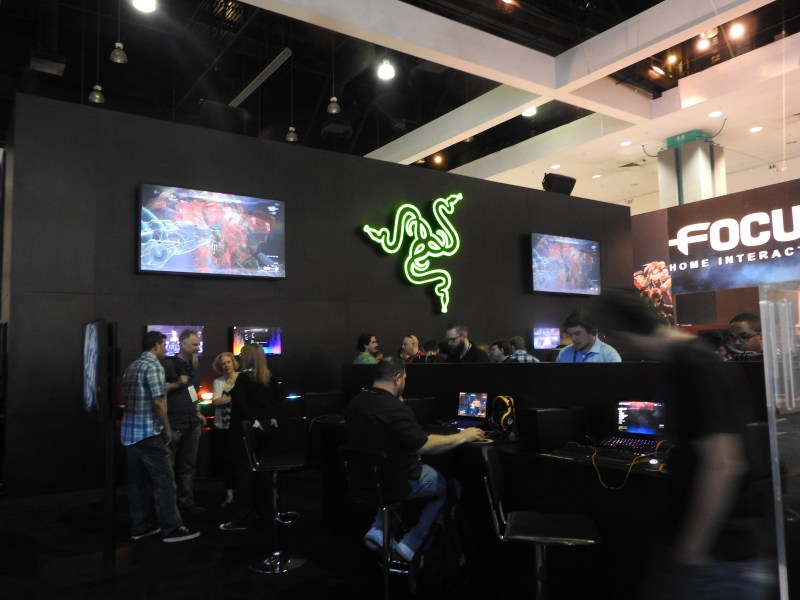
Above: Razer’s booth at Electronic Entertainment Expo in Los Angeles.
GamesBeat: Has the space changed any? Are you at about the same square footage, or have you added space because of the changes in the show?
Gallagher: The show is sold out. Not only are the consumer tickets sold, but unless you have a card table, you couldn’t get in as an exhibitor, in the suites or on the floor. At Club Novo, we’ve opened that up for the Coliseum. We’re also doing things in Microsoft Plaza intended to be very consumer-engaging, very fun, very exciting. Again, we’re providing high value to exhibitors. Those elements are in addition to the footprint you’ve seen in prior years at the L.A. Convention Center. We’re picking up more space so we can give a great experience to our new consumer guests, and also continue to provide a solid platform for announcements and reveals to the professional attendees.
GamesBeat: What do you see as issues in front of the game industry right now?
Gallagher: Other than the Supreme Court case and responding to the false accusations following Newtown, we have this industry engaged at the highest levels I’ve seen in my 10 years on the job. The policies being considered on the federal level are receiving very high levels of attention, not just from game companies, but from gamers themselves. There’s a desire to be heard. That creates opportunity for ESA to be the receiver of that energy and the voice for those issues that matter most to the growth of the industry.
When we first brought the show back in its current format, eight years ago, there were two primary issues on the table for gamers and game companies involving the ESA. One was the protection of intellectual property, ensuring the investment wasn’t being stolen, and the second was the first amendment issues around violent content.
Today, that matrix of issues is much broader, dozens of issues, including things that are very much in the popular debate right now: tax reform, patent reform, copyright reform, immigration reform — the immigration steps the president has sought to make, as well as other things around reforms. All of those are complex. All of those require sustained and thoughtful engagement. We couldn’t be busier right now at ESA when it comes to issues, just on the federal level.
On the state level we continue to see great levels of acceptance and excitement about attracting the jobs this industry represents. The average wage is $97,000 a year. We just put out, in February, a map at areweinyoustate.org. It’s organized by congressional district. When you click on each of those, you can see the exact companies present in those districts. That tool is illustrative of the economic impact our industry has. There’s an appetite, a very strong one, among states to compete for the jobs that we represent. It’s a rich agenda, a very broad one. It continues to provide opportunities for game developers and gamers alike.

Above: Insomniac Games chief Ted Price (left) talks with ESA boss Mike Gallagher on Tuesday at the GamesBeat Summit.
GamesBeat: What’s the latest thinking on diversity issues in the industry?
Gallagher: We’ve had this conversation for several years now. It became most acute about two years ago. What’s going to move the industry in the right direction is sustained effort. It’s not a photo-op, a one-time thing. It’s a constant emphasis on broadening both the game creators and game consumers, making sure that inclusiveness is at the center of what we do. I can say with confidence that every ESA member has that in the center of their target. We have substantial, robust, and committed discussions among ESA members, including board members, when we approach these issues.
We see encouraging signs. From 2009 to the present, according to IGDA, we’ve doubled the percentage of women participating in the industry. When you look at the Higher Education Video Game Alliance, a network of more than 300 universities, they’ve looked into their pipeline to see who’s coming next. Currently more than 30 percent of the students enrolled in their video game programs are women. The retention rate within those programs is more than 90 percent. That compares very favorably to general engineering or computer science, where those numbers are more like 15 percent, and the retention rates are in the 60s.
Not only do we have an industry today that’s focused on inclusiveness, that has a great desire — for its own benefit and for society’s — to reach a fully inclusive state, but then the pipeline is much richer for us than it is for other areas in tech. We know there’s a lot of work that needs to be done, but when you look at what this industry is able to do, we’re a cultural medium. Our medium includes speech and expression. Those types of things will very attractive to women as developers. The right types of games will be attractive for women to play.
We have a broad range of motion pictures and books and music that we consume, for all tastes – men, women, anybody else. In this country we’re fortunate to have all of that. Games are increasingly representing that same opportunity. That’s going to be attractive for women in the years ahead, to be part of the industry. What we see from both game players and the commitment of leading game makers is very encouraging. But again, we recognize we do have a ways to go.
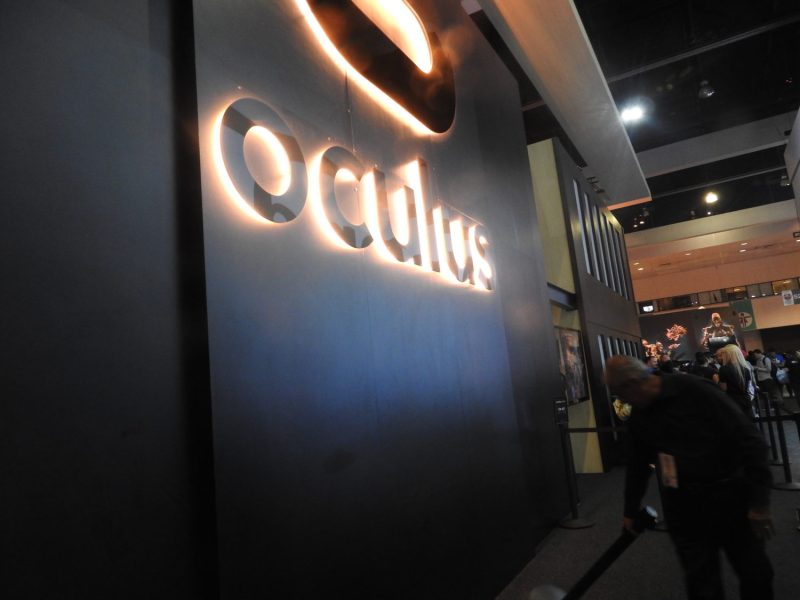
Above: Oculus won’t have a booth at E3 2017. But 126 VR companies will be there.
GamesBeat: Some members have had worries about things like the travel ban and other issues around the Trump administration. [Gallagher moderated a talk at our GamesBeat Summit event with Insomniac CEO Ted Price, who condemned the ban]. Does anything rise to the top for you on that front?
Gallagher: I’d say there is vigilance. It’s ESA’s job to be the focal point of that vigilance around shifts in policy. The benefit that we have in this country is the Constitution. We have three co-equal branches of government, and ESA is skilled at working with all three. We’ve won 13 federal court decisions on free speech, including at the Supreme Court. We’re fully engaged with Congress. We have two caucuses formed that embrace video games — the E-Tech caucus, launched five years ago, with more than 120 members, and the VR/AR/MR caucus, launched about a month ago. Both of these are bipartisan and focused on embracing the excitement of interactive entertainment. You also have our advocacy with the administration over the last 20 years.
The key thing we seek to make progress with is not being distracted by personalities and other things we can’t impact. Stay focused on the key priorities and make sure the policies end up in the right place. Use all the tools available to us because of our Constitution. That’s the lens through which the ESA is executing its mission.
We see opportunity when you talk about immigration. H1-B reform — if we were to remove thousands of H1-B abuses in the system, those thousands of slots open and become possible video game employees or video game entrepreneurs that could come to this country. Our industry doesn’t participate in those types of abuses. When we talk about NAFTA reform, that incorporates the notion of digital trade be one of the primary elements, because it wasn’t contemplated 25 years. When you look at tax reform, there are a number of ways this could be advantageous for game-makers. We are tech companies. There’s an opportunity to bring significant amounts of cash back to the United States and invest it back in this economy, in growing the industry here. We also have the prospect of lower rates.
Elements of this could be very advantageous. We have to balance those with elements where we have to be vigilant, to ensure that we don’t have negative impacts on the industry, like the travel ban that was proposed early on. It’s a full range of activity. We’re looking at defeating those elements that would be harmful to the industry and amplifying those that could be beneficial. We’re taking a long-term view.
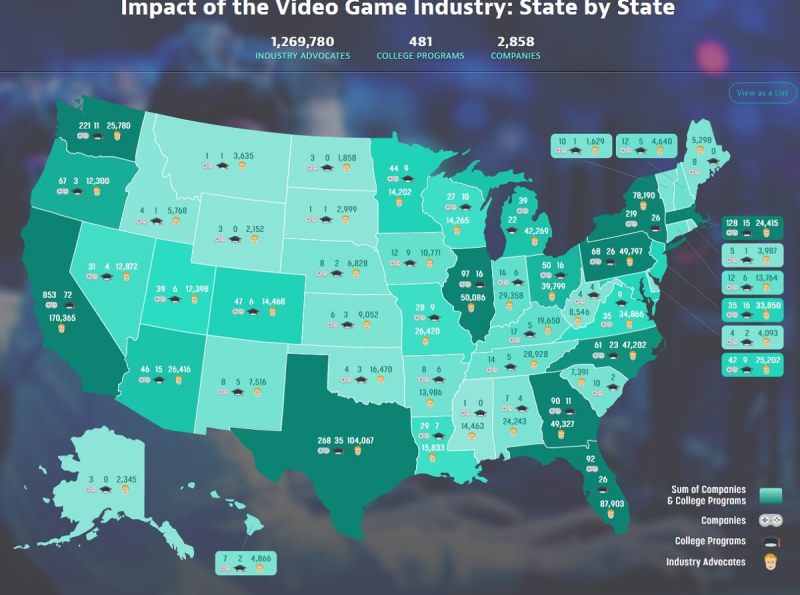
Above: The ESA’s report on game jobs and companies in the U.S.
GamesBeat: Where does the American industry stand in the global picture for game jobs? The U.S. has taken a laissez-faire attitude in the past. I wonder what you think about how competitive the U.S. still is as far as keeping those jobs in the country.
Gallagher: The ESA has an international board and an international membership. We have leading Japanese companies, French companies, U.S. companies, and on and on. All of these companies have international footprints. All of them look at the world as the opportunity. They speak through the ESA in North America, but they look at the world for all of their decisions.
I continue to hear and see great reasons for optimism when it comes to the ability of this country to continue to have a leading position in game-making. But it has to be earned every day. Policymakers cannot coast or expect that it will continue. They have to be very engaged to make sure that the environment remains favorable.
It’s not an easy task. Around the world — look what’s happening now, just within the United States. All 50 states now have game companies in them. That shows the democratization of game-making. Game creation is now something that can be done anywhere by anybody. That doesn’t just apply within the borders of the United States. It applies around the world, when you have tools like Unreal and Unity that can be accessed freely over the internet and put to work.
The United States does not have the market cornered on creative genius. What we do have is huge momentum drivers. We have respect for the rule of law. We have a thriving economy. We have a terrific secondary education system. We have protection for intellectual property. Most important, we have freedom of expressions. The government does not tell a game-maker what they can or cannot make. That’s a force multiplier that gives us an advantage even over western Europe.
I’m bullish about the prospects for the U.S., but very clear with policymakers. They need to continue to compete, because other countries are subsidizing the placement of jobs and seeking to displace the U.S. when it comes to making great games. When you look at mobile, it’s the wild west. There is great success being enjoyed by companies founded and operating outside the United States. That’s a signal. We have to continue to earn it every day.
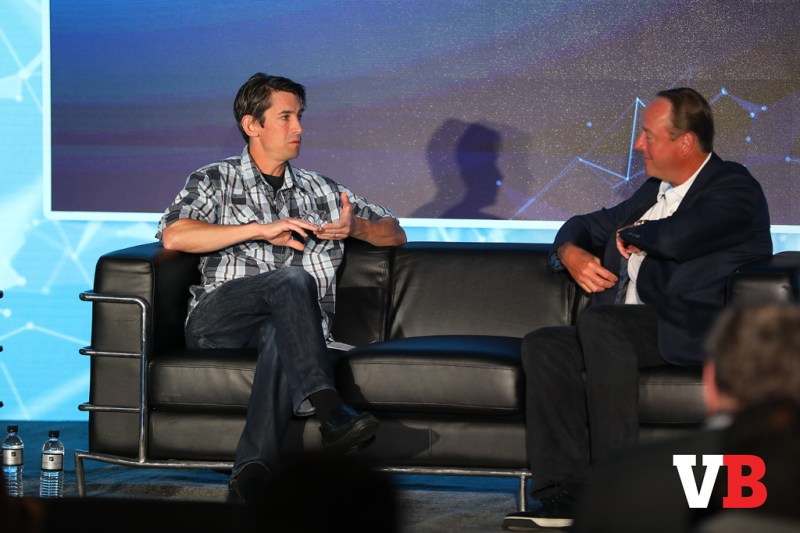
Above: Insomniac’s Ted Price (left) with the ESA’s Mike Gallagher.
GamesBeat: We like to think of the game industry as huge, with $100 billion plus in sales, and yet there are larger tech companies out there. I wonder sometimes if the game industry is still just a pawn relative to those giants.
Gallagher: If we’re a chess piece, we’re the queen. We’re the most powerful and adaptable piece on the board, in my view, although I am biased. If you look at game companies, you have some that are purely about video games. Others have a heritage in electronics or software, or varying commitments to hardware. Looking at the two biggest platforms for revenue, Android and Apple, 90 percent of the revenue generated in the Google Play store comes from games. Yet they’re not engaged in the making of games. The same number is 75 percent on the iOS App Store, but in the same way, they don’t actually make games themselves.
There’s an ecosystem around interactive entertainment that’s incredibly robust and growing. We’re still just shy of 2 billion gamers engaged today. That’s 5 billion more to go, to get everybody playing games and then monetize them. Tremendous growth lies ahead. The most attractive, fastest-growing part of entertainment is interactive entertainment, video games.
If you look at motion pictures, fewer and fewer people go to the movies. They pay higher and higher prices, but the engagement challenge in a theatrical context is significant. In the home market for video, reliable streams like DVD and blu-ray have shrunk dramatically. Streaming has taken over, but that’s given rise to new competitors like Netflix and Amazon. Our industry is leading that type of transition. We’re not the victim of it.
GamesBeat: As a Washington insider, do you know what “covfefe” means?
I’m the last guy to have an answer on that. I have given it zero part of my attention. I would probably say he was trying to say “kerfluffle” but had some difficulty with fat fingers on the phone. We’ll see what late-night TV says about it.

